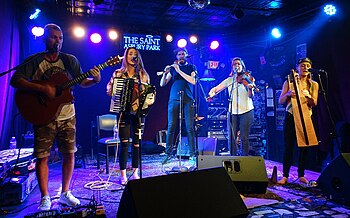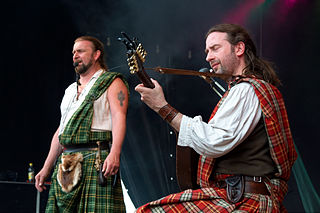
Celtic music is a broad grouping of music genres that evolved out of the folk music traditions of the Celtic people of Northwestern Europe. It refers to both orally-transmitted traditional music and recorded music and the styles vary considerably to include everything from traditional music to a wide range of hybrids.

The Music of Wales, particularly singing, is a significant part of Welsh national identity, and the country is traditionally referred to as "the land of song".
Nansi Richards Jones was a Welsh harpist, sometimes known as the "Queen of the Harp" or by her bardic name "Telynores Maldwyn".

Ar Log are a Welsh folk band. They have performed since the 1970s and are recognized as the first professional Welsh folk band. They perform instrumental music and songs in Welsh.
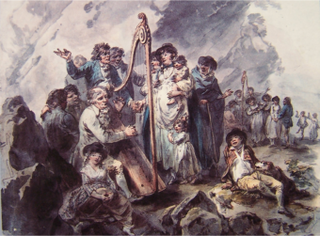
Cerdd Dant is the art of vocal improvisation over a given melody in Welsh musical tradition. It is an important competition in eisteddfodau. The singer or (small) choir sings a counter melody over a harp melody.

Sain, in full – Sain (Recordiau) Cyf. is a Welsh record label, which took part in the Welsh folk revival.

Robin Huw Bowen is a player of the Welsh triple harp, known in Welsh as Telyn Deires ,. He was awarded the Glyndŵr Award in 2000.

The triple harp is a type of multi-course harp employing three parallel rows of strings instead of the more common single row. One common version is the Welsh triple harp, used today mainly among players of traditional Welsh folk music.
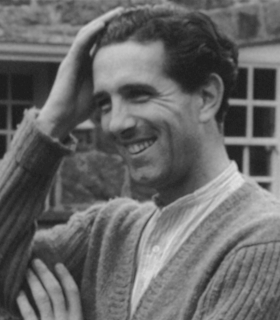
Meredydd Evans, known colloquially as Merêd, was a collector, editor, historian and performer of folk music of Wales. A major figure in Welsh media for over half a century, Evans has been described as influencing "almost every sphere of Welsh cultural life, from folk music and philosophy to broadcasting and language politics".
"Ar Lan y Môr" is a traditional Welsh folk love song. A single verse was published by the Welsh Folk Song Society in 1937, and again in 1948. A slightly different version was recorded by the BBC in 1953. Extra verses have been added, mostly from the 'Hen Penillion'.

Maria Jane Williams was a 19th-century Welsh musician and folklorist born at Aberpergwm House, Glynneath in Glamorgan, South Wales. She rescued many Welsh songs from obscurity, including Y Deryn Pur and Y Ferch o'r Sger.
Robert ap Huw, was a Welsh harpist and music copyist. He is most notable for compiling a manuscript, now known as the Robert ap Huw manuscript, which is the main extant source of cerdd dant and is a late medieval collection of harp music. It is one of the most important sources of early Welsh music.

Plygain is a traditional Welsh Christmas service which takes place in a church between three and six o'clock in the morning, traditionally on Christmas morning.

We'll Keep a Welcome is a 2000 album by singer Bryn Terfel of traditional hymns and folk songs associated with Wales. Terfel was accompanied on the album by the Orchestra of the Welsh National Opera, the Risca Male Choir and The Black Mountain Chorus. The majority of the songs are sung in the Welsh language.
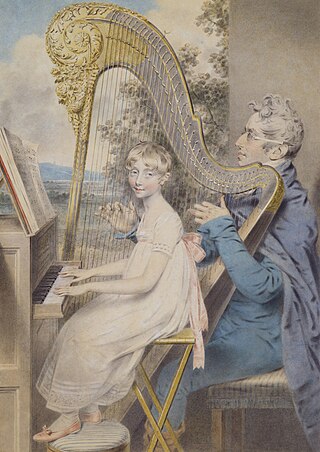
Elizabeth Randles, also known as "Little Cambrian Prodigy", was a Welsh harpist and pianist. A child prodigy, she started playing the piano at the age of sixteen months, and performed in public for the first time before she was two years old. Randles was taught by her blind father who was organist at the Holywell parish church. She performed for local aristocracy, leading to a performance for King George III and his royal family when she was three and a half. Caroline, Princess of Wales, hoped to adopt her but her father did not allow it. She did, however, spend a few days at the Princess of Wales' summer home, often playing with Princess Charlotte of Wales. Randles went on to tour the country as a child, performing with John Parry. In 1808, she returned home and learned the harp. She went on to take lessons from Friedrich Kalkbrenner before moving to Liverpool and becoming a teacher.
Frances Môn Jones was a Welsh harpist and teacher who won three harp competitions and one solo soprano contest at the National Eisteddfod of Wales from 1937 to 1949. She began playing the organ at age 14 before playing the harp. Jones helped W. S. Gwynn Williams to establish the Llangollen International Eisteddfod and played the harp at events. She attended the Royal Northern College of Music from 1955 to 1960 and subsequently retired from performing to teach in schools around the area of her residence.
David Vaughan Thomas or David Vaughan-Thomas, born David Thomas, and known also by his bardic name Pencerdd Vaughan, was a composer, organist, pianist and music administrator. His compositions are deeply influenced by the musical and literary traditions of his native Wales. Though his music is now little performed he has been described as "the leading native Welsh musician of [his] time" and as "one of the most important composers in the transitional period of Welsh music from the Victorian era to our own times". The broadcaster Wynford Vaughan-Thomas was his son.
John Glyn Davies was a Welsh scholar, poet and songwriter, most of whose creative writing is in the Welsh language. His songs for children, often in the form of sea shanties, remain very popular in Wales. He was also the first librarian of the institution which eventually became the National Library of Wales. He has been described as "one of the most remarkable figures of his age".
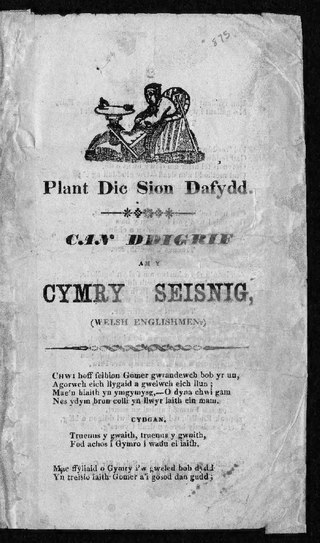
Dic Siôn Dafydd is a satirical stereotype of an Anglophile Welsh person who deliberately turns their back on the Welsh people, their culture and the Welsh language. A Dic Siôn Dafydd instead embraces the concept of Englishness, English culture and the English language. It is traditionally used as an insult.

